

La Grande Famine en Irlande (1846-1851) : objet d'histoire, enjeu de mémoire. Notes Gerald Keegan, Famine Diary : Journey to a New World, édité et présenté par James J.
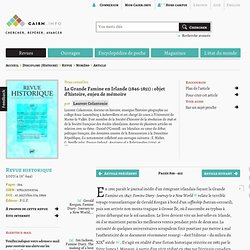
Deutsches Auswandererhaus Bremerhaven. Working Lives. Irish seasonal and migrant workers were a highly mobile and flexible workforce, vital to Britain's booming 19th-century economy and economic revival after the Second World War.
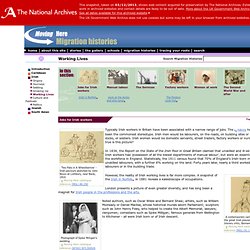
The traditional perception of the Irish navvy is by no means the whole story, but there were many who made a living in this back-breaking way. In 1871, Thomas Ryan was a railway navvy living in the shanty town of Jericho, at Batty Green, near the Ribblehead viaduct in Yorkshire, and working on Midland Railway's Settle to Carlisle line. He had his family with him, and the birthplaces of his children, from Gloucestershire to Scotland, show how mobile they had to be. Histoire en Seconde (Place des Européens dans le peuplement du monde) : Quelques chansons pour illustrer l'émigration vers les Etats-Unis. EUROPE-USA - Nos cousins d'Amérique.
Deuxième groupe « ethnique » derrière les Américains d’ascendance allemande, les descendants d’Irlandais sont plus de 30,5 millions et représentent un peu plus de 10 % de la population des États-Unis.

Ils sont majoritaires dans le nord-est du pays, notamment dans le Delaware, le Massachusetts et le New Hampshire. Au début du XIXe siècle, l’économie irlandaise repose essentiellement sur une agriculture archaïque. Les terres, qui sont la propriété de riches Anglais, sont exploitées par des fermiers irlandais trop pauvres pour investir. Les Irlandais commencent à émigrer vers les États-Unis. Leur flux ne va pas cesser de croître au cours des années. La misère continue de sévir dans l’Irlande du XXe siècle. Irlandais. Jeunes danseuses pour la Saint Patrick - Photo AP Images D'après Kevin Kenny, professeur d'histoire au Boston College, établissement universitaire de Boston.
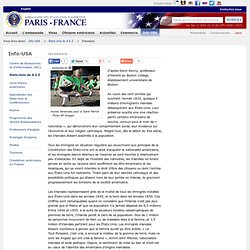
Richard J. Jensen - "No Irish Need Apply": A Myth of Victimization - Journal of Social History 36:2. Write the author at RJensen@uic.eduslightly revised version 12-22-2004 Abstract Irish Catholics in America have a vibrant memory of humiliating job discrimination, which featured omnipresent signs proclaiming "Help Wanted--No Irish Need Apply!
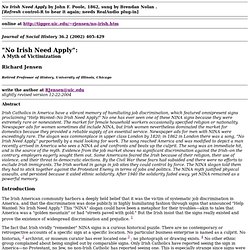
" No one has ever seen one of these NINA signs because they were extremely rare or nonexistent. Lieu historique national de la Grosse-Île-et-le-Mémorial-des-Irlandais - Histoire. Skibbereen Heritage Centre - Great Famine Commemoration Exhibition. The Great Irish Potato Famine of the 1840s is now recognised as the worst humanitarian disaster of 19th century Europe.

In 1841 the population of Ireland was 8.5 million people. By 1850, at least one million people had died in terrible conditions while another million emigrated as refugees. It is estimated that a further half a million births did not take place as a direct result of 'The Great Hunger'. My Heart Remembers Those Lost In Dear Old Skibbereen. Don't bite the hand that's feeding you. Irish Diaspora Studies. Irish Potato Famine: Gone to America. Throughout the Famine years, nearly a million Irish arrived in the United States.

Famine immigrants were the first big wave of poor refugees ever to arrive in the U.S. and Americans were simply overwhelmed. Upon arrival in America, the Irish found the going to be quite tough. With no one to help them, they immediately settled into the lowest rung of society and waged a daily battle for survival. The roughest welcome of all would be in Boston, Massachusetts, an Anglo-Saxon city with a population of about 115,000. It was a place run by descendants of English Puritans, men who could proudly recite their lineage back to 1620 and the Mayflower ship.
Grande Famine en Irlande (1845-1848) - Pénurie alimentaire en Irlande. La Grande Famine en Irlande (1845-1848) a été une période des plus sombres de l’Histoire irlandaise.
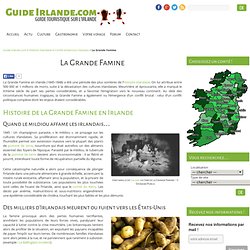
On lui attribue entre 500 000 et 1 millions de morts, suite à la dévastation des cultures irlandaises. Meurtrière et éprouvante, elle a marqué le XIXème siècle de part ses pertes considérables, et a favorisé l’émigration vers le nouveau continent. Au delà des circonstances humaines tragiques, la Grande Famine a également vu l’émergence d’un conflit brutal : celui d’un conflit politique complexe dont les enjeux étaient considérables. Quand le mildiou affame les irlandais… 1845 : Un champignon parasite, « le mildiou », se propage sur les cultures irlandaises. Emigration italienne - Italien dans l'académie de Versailles.
Immigration...Italian: Early Arrivals - For Teachers. Early Arrivals The Genoese navigator Cristoforo Colombo, known to us now as Columbus, was only the first of many Italian explorers who would come to shape the Western Hemisphere as we know it today.
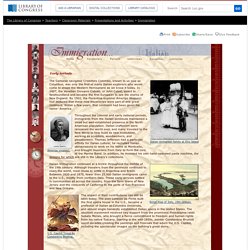
In 1497, the Venetian Giovanni Caboto, or John Cabot, sailed to Newfoundland and became the first European to see the shores of New England. By 1502, the Florentine explorer Amerigo Vespucci had deduced that these new discoveries were part of one great continent. Within a few years, that continent had been given his name--America. Italian immigration continued at a trickle throughout the middle of the 19th century. The impact of their contributions can still be seen today. Italie.pdf (Objet application/pdf)